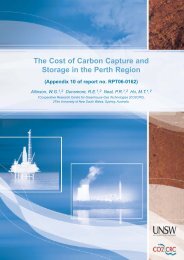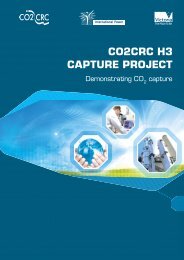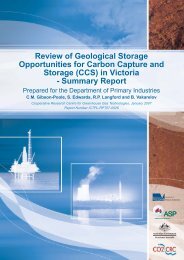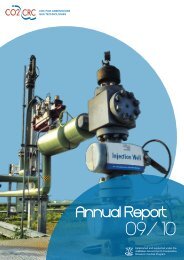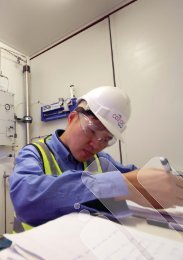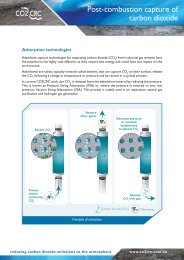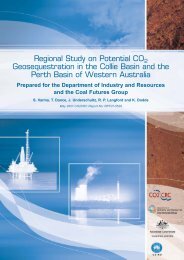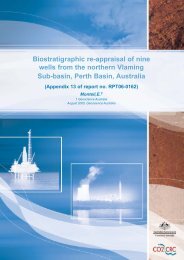Read the full report (PDF27.8 MB) - CO2CRC
Read the full report (PDF27.8 MB) - CO2CRC
Read the full report (PDF27.8 MB) - CO2CRC
You also want an ePaper? Increase the reach of your titles
YUMPU automatically turns print PDFs into web optimized ePapers that Google loves.
Due to its location (proximal to <strong>the</strong> Rockhampton–Gladstone region) and existing pipeline<br />
corridors, <strong>the</strong> Denison Trough in <strong>the</strong> northwest Bowen Basin appears suitably located to act as a<br />
node/distribution centre for multiple CO 2 injection sites in <strong>the</strong> Galilee and Bowen basins.<br />
The east Bowen Basin area (Burunga Anticline, Dulacca area; Figure 2.2b) is located adjacent to <strong>the</strong><br />
township of Wandoan, 300 to 350 km from Brisbane, Rockhampton and Gladstone regions. With<br />
only small CBM (coal bed methane) fields located in this region, <strong>the</strong> smallest area examined, <strong>the</strong><br />
Burunga Anticline/Dulacca area, has limited infrastructure and minimal data on <strong>the</strong> deeper potential<br />
CO 2 storage reservoirs. The limited data indicates a high risk of less than optimal reservoir (using<br />
<strong>the</strong> current minimum cut-off of 50 mD for optimal CO 2 injection).<br />
The Wunger Ridge flank area (Figure 2.2c) contains significant producing hydrocarbon<br />
accumulations and associated infrastructure. Located in <strong>the</strong> southwest Bowen Basin, it is suitably<br />
placed to accept CO 2 emissions from a sou<strong>the</strong>ast Queensland hub servicing <strong>the</strong> greater Brisbane<br />
area. Direct pipeline access to Brisbane, via <strong>the</strong> Jackson–Moonie–Brisbane oil pipeline potentially<br />
provides an easement for CO 2 infrastructure.<br />
The sou<strong>the</strong>ast Bowen Basin area (Figure 2.2d) is <strong>the</strong> closest region to Brisbane, less than 300<br />
kilometres, and has direct pipeline access via <strong>the</strong> Roma–Brisbane gas pipeline in <strong>the</strong> north and <strong>the</strong><br />
Jackson–Moonie–Brisbane oil pipeline in <strong>the</strong> south. The sou<strong>the</strong>ast Bowen Basin area has very<br />
minor hydrocarbon production and as such has little internal infrastructure.<br />
Work is presently being conducted by a private consortium that is considering building an<br />
integrated gasification combined cycle (IGCC) plant in Queensland (IEAGHG, 2005). This<br />
consortium may have to consider injection in less than optimal reservoirs with a minimum average<br />
permeability of around 2–5 mD. If this innovative programme is successful in injecting CO 2 at rates<br />
which match <strong>the</strong> expected emissions, <strong>the</strong>n <strong>the</strong> east and sou<strong>the</strong>ast Bowen Basin areas could<br />
potentially become attractive.<br />
2.2. CO 2 Properties<br />
Industrial and power generation processes in <strong>the</strong> state of Queensland are currently emitting large<br />
volumes of CO 2 with power usage and corresponding CO 2 emissions expected to grow significantly<br />
in <strong>the</strong> coming years. If geological storage of CO 2 is to have a significant impact on <strong>the</strong>se emissions<br />
<strong>the</strong>n storage space must be used effectively.<br />
Injecting CO 2 in a supercritical phase has major benefits for injectivity and storage efficiency. In a<br />
supercritical phase, <strong>the</strong> CO 2 has a viscosity less than <strong>the</strong> liquid phase, a diffusivity similar to <strong>the</strong> gas<br />
phase, but has been compressed to <strong>the</strong> point were it has similar density to <strong>the</strong> liquid phase<br />
(Table 2.1). Having CO 2 in a supercritical phase greatly increases <strong>the</strong> volume of CO 2 able to be<br />
stored within a geological formation. At 800 m, <strong>the</strong> pressure exerted at depth is approximately 8<br />
Mpa, and <strong>the</strong> temperature is normally greater than 32 0 C, which are <strong>the</strong> conditions at which CO 2<br />
enters a supercritical phase (Figure 2.3, Bachu, 2001). Therefore, having a reservoir–seal pair at<br />
depths greater than 800 m is desirable for CO 2 storage.<br />
Table 2.1. Physical properties of Carbon Dioxide (After Cook et al., 2000).<br />
Phase Density (g/mL) Viscosity (poise) Diffusivity (cm 2 /s)<br />
Gas 0.001 0.00005–0.00035 0.1–1.0<br />
Supercritical fluid 0.2–0.9 0.002–0.001 0.00033<br />
Liquid 0.8–1.0 0.003–0.024 0.000005–0.00002<br />
8


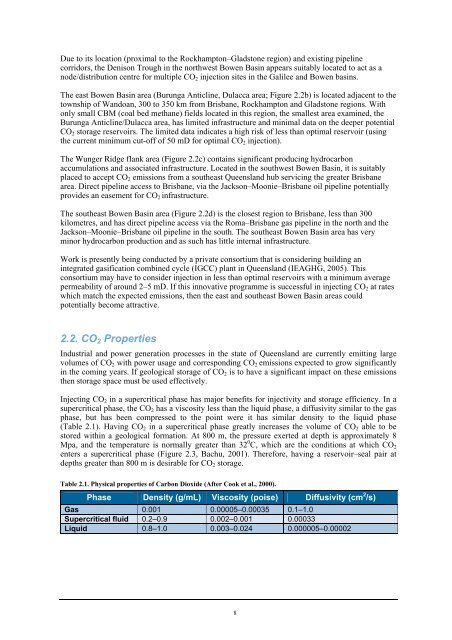
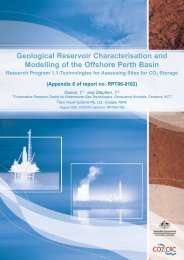
![Post-combustion solvent absorption [PDF 438KB] - CO2CRC](https://img.yumpu.com/48575763/1/184x260/post-combustion-solvent-absorption-pdf-438kb-co2crc.jpg?quality=85)

